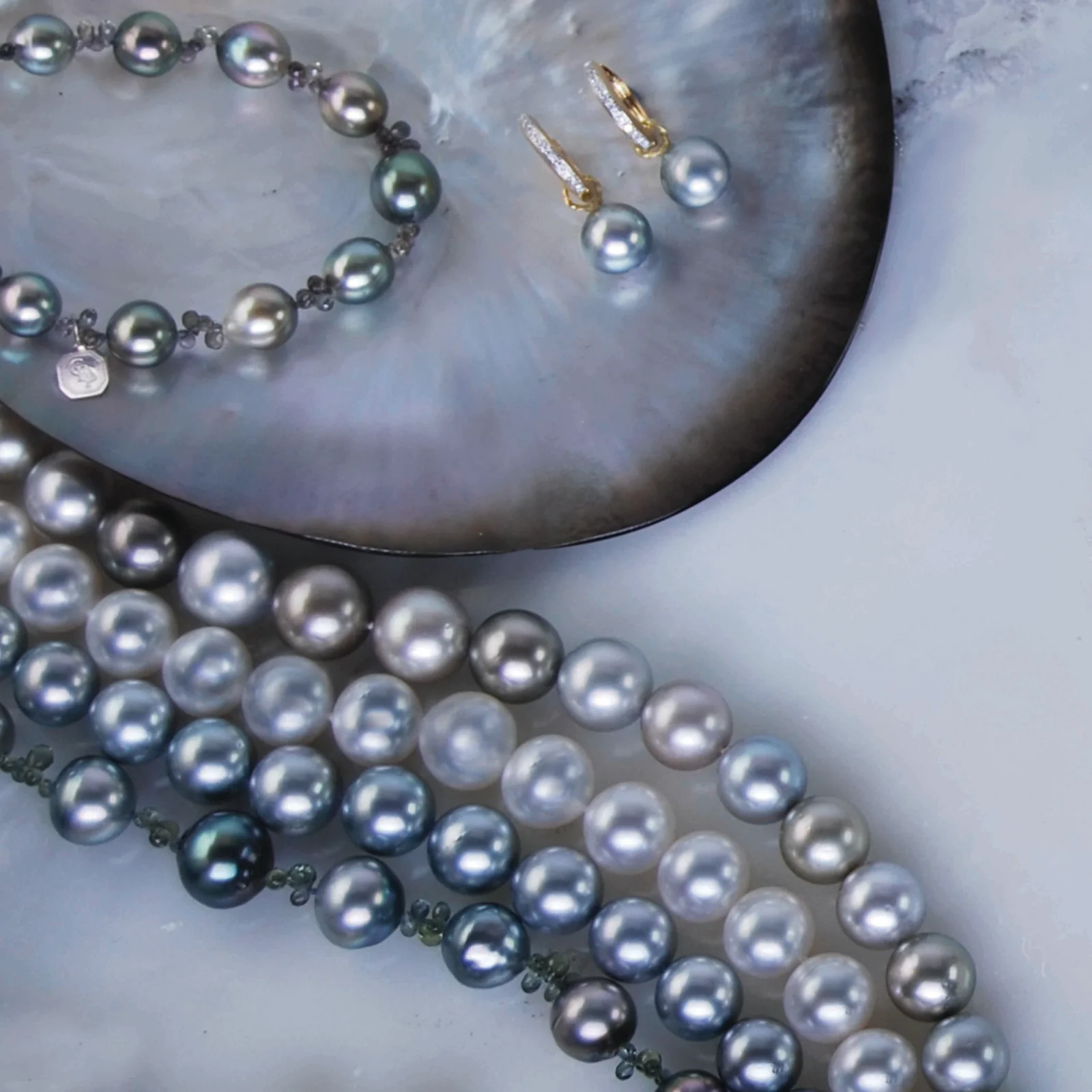
Tahitian pearls are prized for their rarity and beauty. As saltwater gems, Tahitian pearls are only cultivated in a handful of international locations, where they are painstakingly produced by experts in the industry. They are therefore highly sought-after and valued, making any item of Tahitian pearl jewellery a true investment piece.
Pearl experts since 1989, Coleman Douglas Pearls creates an array of eye-catching jewellery with Tahitian pearls. In this essential guide, we’ll cover everything you need to know about these iridescent gems, from why they are so valuable to what creates their unique dark hue. Read on to learn more.
Everything you need to know about Tahitian pearls
Why are Tahitian pearls black?
Tahitian pearls are naturally darker in colour than other varieties because they are produced in black lipped oysters. By comparison, South Sea pearls are produced in silver or gold lipped oysters. Tahitian pearls can come in a range of tones, including grey, black, peacock green and even an aubergine purple. More rarely, lighter hues such as white, yellow, or pink (which will all have grey overtones) are cultivated.
As a result, Tahitian pearl jewellery can complement a range of skin tones and hair colours, depending on the shade of pearl chosen by the wearer. Given their moody hues and multi-tonal surface, they also dramatically elevate any outfit.
Where do Tahitian pearls come from?
Produced in the warm ocean waters of French Polynesia, East Australia, Panama and Mexico, Tahitian pearls are saltwater pearls formed in black lipped oysters. Almost all Tahitian pearls available on the market are ‘cultivated pearls’, meaning that they are created with human intervention. Conversely, natural Tahitian pearls are incredibly rare and are found as collectors pieces in private and royal collections.
The process of Tahitian pearl cultivation involves adding a mother of pearl bead as an ‘irritant’ to a black lipped oyster. This irritant causes the oyster to produce epithelial cells, which in turn create a spherical pearl sac around the irritant through the deposition of concentric layers of nacre. If the oyster does not react in this way, it will die, meaning that pearls are a natural by-product of an oyster’s defensive strategy.
Over time, as the nacre is deposited and developed, the oyster will produce a spherical pearl. Generally larger than their freshwater counterparts, Tahitian pearls can grow to anywhere from 8mm to 18mm in diameter.
Are Tahitian pearls freshwater or saltwater?
Tahitian pearls are saltwater gems, meaning that they are both more prized and valuable than freshwater pearls. They should be treated with more care than their more robust freshwater counterparts. Tahitian pearls also grow in protected ocean inlets and are considered more precious than freshwater pearls due to their comparative rarity and almost perfectly spherical shape.
Are Tahitian pearls valuable?
Blemish-free Tahitian pearls are prized for a number of reasons, including their beauty, lustre and the length of the growth process. Second only to South Sea pearls in rarity, Tahitian pearls are painstaking to cultivate, and can only be found in a select few exotic locations.
As saltwater pearls, the production of Tahitian pearls is laborious and delicate – it can take up to three years to produce a single Tahitian pearl. In comparison, freshwater pearls can be cultivated in half that time and as such, are more affordable.
In fact, freshwater molluscs can produce up to 120 pearls in their lifetime, whereas each black lipped oyster used to cultivate Tahitian pearls only produces one or two pearls in its whole lifetime. And even then, the pearls produced may not be of the quality required for premium jewellery pieces such as our Tahitian pearl earrings. On average, only around 5% of any pearl harvest meets the high standard required. Jewellery made from genuine saltwater Tahitian pearls is therefore very valuable.
Factors including the size, shape and lustre of each pearl will determine its value. However, the right piece of Tahitian pearl jewellery for each individual wearer will depend on that wearer’s unique features, including their skin tone and hair colour. Our guide to complementary pearl colours will help you to pick the right tone for you.
What is special about Tahitian pearls?
Tahitian pearls are the only naturally black pearls. Although freshwater pearls are often sold in darker hues, these shades can only be achieved by either dying or treating the pearls with specific processes. This elevates the price and value of Tahitian pearl jewellery, making them a popular choice for special occasions.
In contrast to traditional white pearl designs, the exquisite dark hue of Tahitian pearl necklaces will bring a contemporary twist to any look. Tahitian pearls are easy to style with a variety of outfit colours. They will also add a luminescent glow to the wearer because of the way they reflect and refract the light.
New to the trend? Discover more tips on how to wear Tahitian pearls on our blog or If you’d like to learn more about Tahitian Pearls, watch this video…
Browse Tahitian pearl jewellery at Coleman Douglas Pearls
As multi award-winning pearl jewellery designers, Coleman Douglas Pearls are experts in the industry, taking pride in our contemporary Tahitian pearl jewellery designs.
From delicate pearl drop earrings to luxury single strand pearl necklaces, our full collection is available to explore online. Alternatively, if you’d like to create a custom design to suit your style, complexion and budget, feel free to send us an enquiry.



















